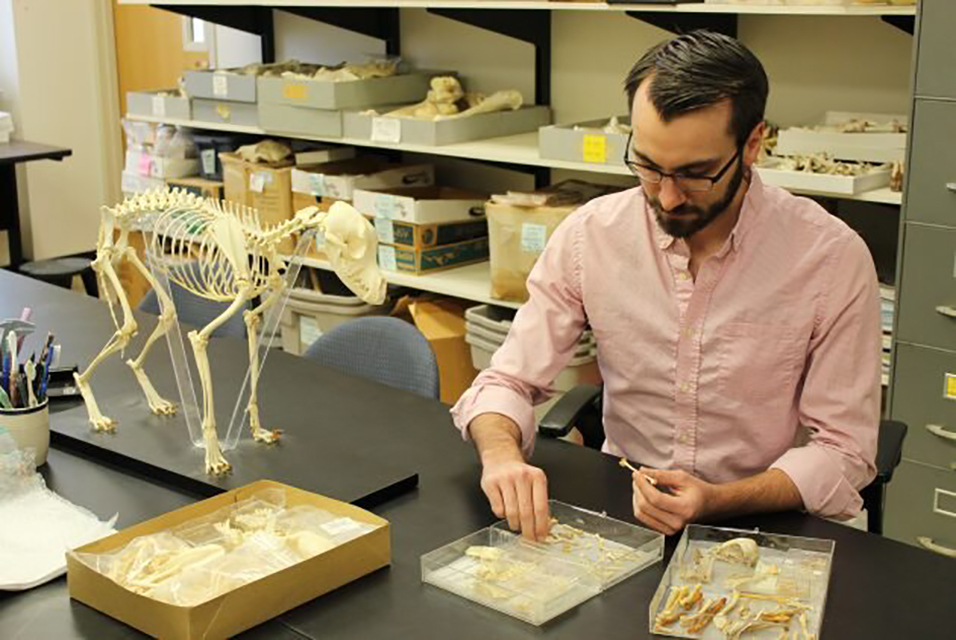MANSFIELD, CT.- In Connecticut, deer are a frequent sight, whether they are quietly munching on plants around our yards, bounding into the cover of trees with a flash of white from their tails, or after they don't safely make it across a busy road. Though we may take them for granted, these deer have been here for millennia, and their story is intertwined with the human story of our region.
Elic Weitzel is a
UConn anthropology Ph.D. candidate studying resource management from the past, and the history of white-tailed deer in the region is providing a glimpse into what life was like for people in Connecticut centuries ago.
Weitzel analyzed thousands of animal bones from a Wangunk tribal settlement just south of present-day Hartford to learn more about the Wangunk and to glean information about their hunting practices, specifically to look for evidence that hunting in the pre-colonial period had negative impacts on deer. His findings are published in the Journal of Archaeological Science: Reports.
The site, called the Morgan Site, was a maize horticultural village occupied from the 11th to 14th centuries, explains Weitzel, and the data indicate interesting patterns about white-tailed deer in Connecticut, supporting a hypothesis that white-tailed deer are resilient to overhunting by humans.
"I think it's an important data point for wildlife managers, for archaeologists, and for everybody to understand what's going on with deer in New England," says Weitzel.
After the white-tailed deer population grew to near-ubiquity around 8,000 years ago, Weitzel says the species became an important food resource for those living in eastern North America. Indigenous populations hunted the deer for thousands of years and later, European settlers in the colonial period also relied heavily on deer, nearly driving the species to extinction. Weitzel is hoping to set a pre-colonization baseline of the white-tailed population to better understand how the deer's resilience changed post-European contact.
"Archaeologists struggle to find clear evidence that white-tailed deer populations were ever negatively impacted by Native hunting. I've looked at archaeological sites in Alabama and I didn't find evidence of over-exploitation of white-tailed deer going on."
"Ecologists estimate that there might have been between 9 and 18 million white-tailed deer on the eve of European colonization, around 15-1600 AD, but we know for sure that by 1900 AD, just 123 years ago, there were only 300,000 white-tailed deer in all North America. That is only one to five percent of what their original population was after thousands of years that Native folks were hunting deer regularly."
Weitzel analyzed around 3,000 animal bones excavated from the Morgan Site, representing species like raccoons, turtles, a black bear, and bobcat bones, but the majority belonged to the abundant white-tailed deer, which is why he focused on that species.
Other lines of evidence indicate the presence of a high population of deer, says Weitzel, such as finding complete skeletons.
"When a hunter goes out far away, they're generally not going to drag an entire carcass back home: they'll butcher it in the field, remove the lower utility pieces, and bring back the higher yield parts. When you're closer to home, you might be able to drag the whole carcass back and that seems to be the pattern that's dominating this site. It doesn't seem like they were really having to go too far away to hunt because of the high deer populations close to the site."
Weitzel also found that the skeletons were primarily from adult animals, indicating low hunting pressure. He explains that when a species' population starts to decline, hunters may start seeking out younger animals, however, Weitzel found no fawns and few yearlings represented at the site.
"I think the most surprising result was the size of the deer that I identified in this assemblage—these were big deer. Some of the antlers are on par with record-holding animals from today and I was able to calculate the estimated live weight of these deer. For example, in Connecticut today, deer pretty much don't get larger than 200 pounds but the largest deer on this site was 265 pounds. The largest deer in Connecticut today is pretty much only the average deer from this site," says Weitzel.
Deer body size is sensitive to food availability and indicates how productive the environment is. Weitzel thinks this makes the case that the productive environment supporting these deer populations was carefully managed by the Indigenous population through methods such as prescribed burns to promote a lush and sustainable landscape.
Weitzel notes the 95 to 99% mortality of deer is parallel to some of the higher estimates for what happened to the Native human population post-contact.
"I don't think that's a coincidence. I think that fundamentally the same processes are at work in both cases in a general ecological sense, not necessarily the epidemic disease part, but the fact that it is something new when you have Euro-American settlers colonizing the region and changing the ecology in various ways and it is impacting people, it is impacting animals, it is impacting plants. It's impacting the entire ecosystem of eastern North America, in negative ways."
These findings also challenge deeper assumptions about human nature. Weitzel points out that many believe that humans are inherently bad for the environment and separate from nature, yet there is ample evidence to suggest otherwise. Findings such as these can tell us a lot about ourselves as a species and our own economic systems and role in our ecosystem.
"To my mind, it's not the existence of people that causes negative environmental impacts, it's certain things that certain people do. We know that Indigenous people all over the world and throughout time have had positive impacts on the environment. One of my favorite examples is from western Australia where in the early 20th century, the Australian government removed Aboriginal Australians from their territories."
"There were extinctions and ecological collapse because they removed humans, an integral piece of an ecosystem, and once you remove them from that equation, the ecosystem suffered. Once Aboriginal peoples were allowed to return to their home territories, the ecosystem started to thrive and flourish again."
Weitzel hopes this research can help inform wildlife managers and ecologists to understand the historical ecology of the species, and to establish baselines for sustainable management. Since there is so much that is still unknown, this work will help answer some of those questions, such as what were the exact causes and mechanisms for the high mortality rates in the white-tailed deer population? Weitzel is digging into this and other questions for the rest of his dissertation.
"Wildlife managers often struggle to figure out what the baseline should be that they're trying to return to. Archaeological data contributes to that, but I also think this contributes to broader discussions about how humans interact with their environment, and that there are ways that we can manage environments sustainably and interact with resources sustainably. That seems to be what Native folks were doing and then there are ways that we can interact unsustainably and that seems to be what happened in the colonial period."










